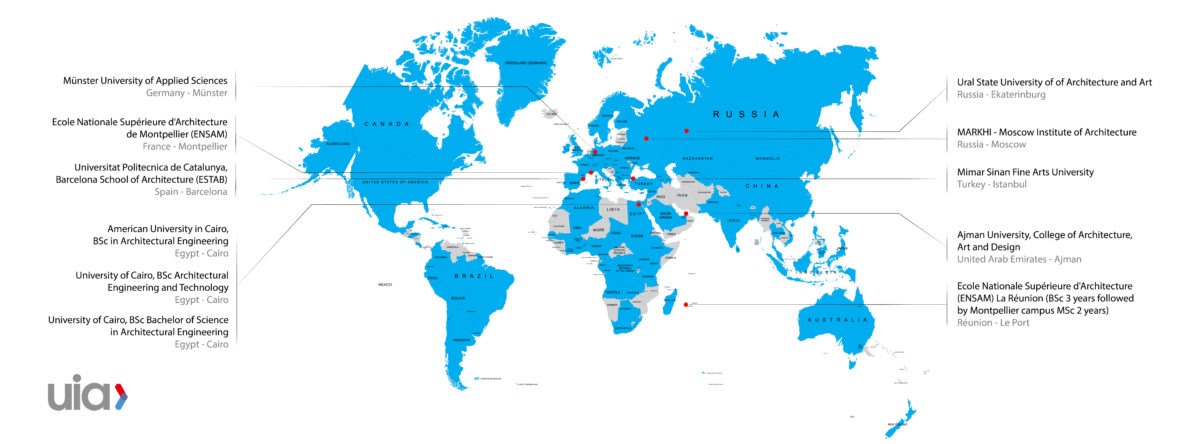
UNESCO-UIA Validation Board
The UNESCO-UIA Validation Commission aims to set an international standard for excellence in architectural education, ensuring the prestige and integrity of validated schools.
The UNESCO-UIA Charter on Architectural Education, published in 1996, lays out a series of guidelines aimed at ensuring that young architects receive an education that fully prepares them to meet the professional, social and cultural challenges of the globalised profession. The Charter acts as the basis for the UNESCO-UIA Study Programme Validation.
APPLY FOR UNESCO-UIA STUDY PROGRAMME VALIDATION
UNESCO-UIA architectural study programme validation
The recognition of architecture study programs by the UNESCO-UIA Validation represents an internationally benchmarked assessment of quality in architectural education. Assessment is carried out through a process of robust, unbiased, evidenced-based peer review. The UNESCO-UIA Validation advances the creation of a global network of recognized architecture programs, putting certified institutions and their students at a great advantage.
In its role as keeper and advocate of the UNESCO-UIA Charter for Architectural Education, UNESCO-UIA maintains a significant overview of the Canberra Accord, a global system for recognizing the substantial equivalence of validation systems. The Charter is reviewed every 6 years by the UIA Education Commission. The Royal Institute of British Architects [RIBA] acts as the system operator of the UNESCO-UIA Validation System.
The advantages of UNESCO-UIA validation
- Validation of architecture study programmes by UNESCO-UIA is defined according to benchmarks for quality in architecture education, and lies at the heart of the UIA’s ethos; the longevity and international reach of the organisation (and variety of schools/countries recognised by the UIA) is proof that those benchmarks are respected and credible.
- UNESCO-UIA validation provides evidence of robust peer group review of programmes in architecture by distinguished and highly experienced practitioners, academics, and students/graduates of architecture; report groups are formed from individuals with a broad constituency of interests, expertise, and background working to defined procedures and acting in an entirely unpartisan manner.
- The 16 criteria used for validation include the 11 points of the European Directive for Architects; these form the basis for other well-established validation systems working internationally, including those of the Royal Institute of British Architects and the Commonwealth Association of Architects.
- However, the additional 5 validation criteria used by UNESCO-UIA form a further level of interrogation of academic standards and learning outcomes, and include consideration of heritage, conservation, as well as attitudes to the development of resource efficient and sustainable architecture.
- UNESCO-UIA validation is an evidence-based process, i.e. the work produced by students of architecture provides the key items from which a report group develops its recommendations; it is this evidence-based approach that places students and their work at the centre of UNESCO-UIA validation.
- UNESCO-UIA validation contributes to the creation of a global network of schools of architecture, and their staff and students.
- UNESCO-UIA has a significant overview of the Canberra Accord, the global system for recognising substantial equivalence of validation systems.
If you would like to volunteer to be part of an assessment visiting committee, please contact us at uia@uia-architectes.org
Deniz İncedayi
Turkey
Nuno Soares
Macao SAR China
Jana Revedin
Germany
Jenny Russell
United Kingdom
Julie Fernandez
France
Pietro Fulvio Cali
Italy
Vladimir Slapeta
Czechia
Gocha Mikiashvili
Georgia
Fani Vavili-Tsinika
Greece
Olena Oliynik
Ukraine
Francisco Manuel Beltrán Rapalino
Colombia
José Ignacio Pacheco Diaz
Peru
Christine Landorf
Australia
Tong Zhang
China
XiaoXiang Tang
China
Hay Lin Helen Leung
Hong Kong SAR China
Belang O. Rapalai
Botswana
Sherine Wahba
Egypt
Susan Kibue
Kenya
Serban Tiganas
Romania
Nikita Tokarev
Russia
Md. Nawrose Fatemi
Bangladesh
Sanjaya Uprety
Nepal
Nicodème Mbainadji
Chad
Basil Agoha
Nigeria
Hanen Ben Rhouma
Tunisia
- The UNESCO-UIA Validation System Procedures Manual for Study Programmes and Systems (updated July 2023)
- The UNESCO-UIA Validation System Procedures Manual for Study Programmes and Systems
- UNESCO-UIA Charter for Architectural Education (updated July 2023)
- UNESCO-UIA Charter for Architectural Education (revised English edition 2017)
- UNESCO-UIA Charter for Architectural Education (Bulgarian edition)
- UNESCO-UIA Charter for Architectural Education (French edition)
- UNESCO-UIA Charter for Architectural Education (Korean edition)
- UNESCO-UIA Charter for Architectural Education (Portuguese edition)
- UNESCO-UIA Charter for Architectural Education (Romanian edition)
- UNESCO-UIA Charter for Architectural Education (Ukranian edition)
- STRATEGIC PLANNING DOCUMENT 2017-2021
- Activity Report 2020: Education Commission